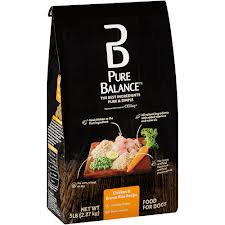
DogFoodAdvisor is reader supported See how
All reviews are 100% impartial but if you buy using links on this page, we may earn a referral fee.
Our Verdict
Pure Balance dry product range is made up of two recipes with ratings varying from 4 to 4.5 stars. The average rating of the whole range is 4.5 stars.
The table below shows each recipe in this range including our rating and the AAFCO nutrient profile: Growth (puppy), Maintenance (adult), All Life Stages, Supplemental or Unspecified.
| Product line | Rating | AAFCO |
|---|---|---|
| Pure Balance Chicken and Brown Rice | 4.5 | A |
| Pure Balance Lamb and Brown Rice | 4 | A |
Recipe and Label Analysis
Pure Balance Chicken and Brown Rice was selected to represent both products in the line for detailed recipe and nutrient analysis.
Pure Balance Chicken and Brown Rice
Estimated Dry Matter Nutrient Content
Protein
Fat
CarbsCarbohydrates
Chicken, chicken meal, dried peas, brown rice, pea protein, dried beet pulp, poultry fat (preserved with mixed tocopherols), brewers rice, natural flavor, whole flaxseed, rice bran, oatmeal, sunflower oil, dried egg product, salt, yeast, dried carrots, dicalcium phosphate, menhaden fish oil, potassium chloride, zinc proteinate, dried cranberry, vitamin E supplement, iron proteinate, l-ascorbyl-2-polyphosphate (source of vitamin C), lactic acid, copper proteinate, mixed tocopherols (used as a preservative), choline chloride, manganese proteinate, biotin, niacin supplement, d-calcium pantothenate, sodium selenite, l-carnitine, bacillus coagulans fermentation product, vitamin A supplement, riboflavin supplement, thiamine mononitrate, rosemary extract, vitamin B12 supplement, calcium iodate, pyridoxine hydrochloride (source of vitamin B6), vitamin D3 supplement, folic acid
Fiber (estimated dry matter content) = 5%
Red denotes any controversial items
| Estimated Nutrient Content | |||
|---|---|---|---|
| Method | Protein | Fat | Carbs |
| Guaranteed Analysis | 27% | 15% | NA |
| Dry Matter Basis | 30% | 17% | 45% |
| Calorie Weighted Basis | 26% | 35% | 39% |
Ingredients Analysis
The first ingredient in this dog food is chicken. Although it is a quality item, raw chicken contains up to 73% water. After cooking, most of that moisture is lost, reducing the meat content to just a fraction of its original weight.
After processing, this item would probably account for a smaller part of the total content of the finished product.
The second ingredient is chicken meal. Chicken meal is considered a meat concentrate and contains nearly 300% more protein than fresh chicken.
The next ingredient is brown rice, a complex carbohydrate that (once cooked) can be fairly easy to digest. However, aside from its natural energy content, rice is of only modest nutritional value to a dog.
The fourth ingredient includes dried peas. Dried peas are a good source of carbohydrates. Plus they’re naturally rich in dietary fiber.
However, dried peas contain about 27% protein, a factor that must be considered when judging the meat content of this dog food.
The fifth ingredient is pea protein, what remains of a pea after removing the starchy part of the vegetable.
Even though it contains over 80% protein, this ingredient would be expected to have a lower biological value than meat.
And less costly plant-based products like this can notably boost the total protein reported on the label — a factor that must be considered when judging the meat content of this dog food.
The sixth ingredient is beet pulp. Beet pulp is a controversial ingredient, a high fiber by-product of sugar beet processing.
Some denounce beet pulp as an inexpensive filler while others cite its outstanding intestinal health and blood sugar benefits.
We only call your attention here to the controversy and believe the inclusion of beet pulp in reasonable amounts in most dog foods is entirely acceptable.
The seventh ingredient is chicken fat. This item is obtained from rendering chicken, a process similar to making soup in which the fat itself is skimmed from the surface of the liquid.
Chicken fat is high in linoleic acid, an omega-6 fatty acid essential for life. Although it doesn’t sound very appetizing, chicken fat is actually a quality ingredient.
The next ingredient is brewers rice. Brewers rice is a cereal grain by-product consisting of the small fragments left over after milling whole rice. Aside from the caloric energy it contains, this item is of only modest nutritional value to a dog.
After the natural flavor, we find flaxseed, one of the best plant sources of healthy omega-3 fatty acids. Provided they’ve first been ground into a meal, flax seeds are also rich in soluble fiber.
However, flaxseed contains about 19% protein, a factor that must be considered when judging the actual meat content of this dog food.
From here, the list goes on to include a number of other items.
But to be realistic, ingredients located this far down the list (other than nutritional supplements) are not likely to affect the overall rating of this product.
With four notable exceptions…
First, we find sunflower oil. Sunflower oil is nutritionally similar to safflower oil. Since these oils are high in omega-6 fatty acids and contain no omega-3’s, they’re considered less nutritious than canola or flaxseed oils.
Sunflower oil is notable for its resistance to heat damage during cooking.
There are several different types of sunflower oil, some better than others. Without knowing more, it’s impossible to judge the quality of this ingredient.
Next, this food includes dried egg product, a dehydrated form of shell-free eggs. Quality can vary significantly. Lower grade egg product can even come from commercial hatcheries – from eggs that have failed to hatch.
In any case, eggs are easy to digest and have an exceptionally high biological value.
Next, this food contains chelated minerals, minerals that have been chemically attached to protein. This makes them easier to absorb. Chelated minerals are usually found in better dog foods.
And lastly, this product includes sodium selenite, a controversial form of the mineral selenium. Sodium selenite appears to be nutritionally inferior to the more natural source of selenium found in selenium yeast.
Nutrient Analysis
Based on its ingredients alone, Pure Balance Chicken and Brown Rice looks like an above-average dry product.
The dashboard displays a dry matter protein reading of 30%, a fat level of 17% and estimated carbohydrates of about 45%.
As a group, the brand features an average protein content of 28% and a mean fat level of 17%. Together, these figures suggest a carbohydrate content of 48% for the overall product line.
And a fat-to-protein ratio of about 60%.
Above-average protein. Near-average fat. And near-average carbs when compared to a typical dry dog food.
Even when you consider the protein-boosting effect of the dried peas and flaxseed, this looks like the profile of a kibble containing a notable amount of meat.
Pure Balance Dog Food Recall History
The following automated list (if present) includes all dog food recalls related to Pure Balance through April 2025.
No recalls noted.
You can view a complete list of all dog food recalls since 2009 here.
Our Rating of Pure Balance Dog Food
Pure Balance is a grain-inclusive dry dog food using a notable amount of named meat meal as its dominant source of animal protein, thus earning the brand 4.5 stars.
Compare Pure Balance Dog Food
How does Pure Balance compare with The Dog Food Advisor's most recommended brands?
A Final Word
The Dog Food Advisor does not accept money, gifts, samples or other incentives in exchange for special consideration in preparing our reviews.
However, we do receive a referral fee from online retailers (like Chewy or Amazon) and from sellers of perishable pet food when readers click over to their websites from ours. This helps cover the cost of operation of our free blog. Thanks for your support.
For more information, please visit our Disclaimer and Disclosure page.








